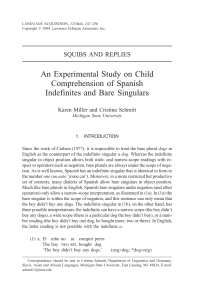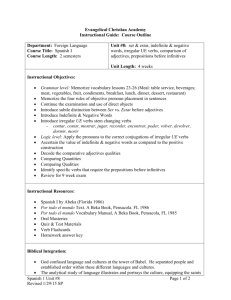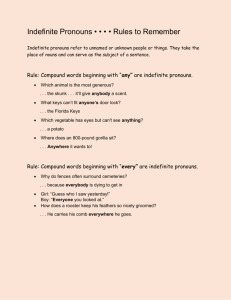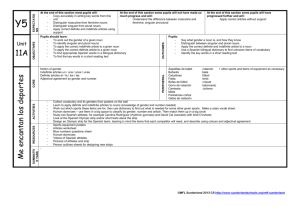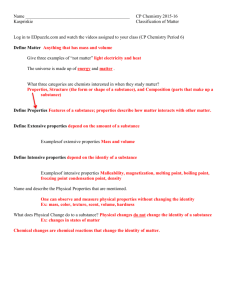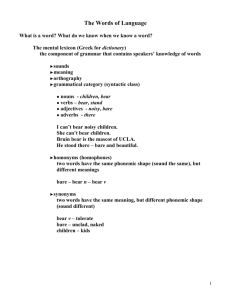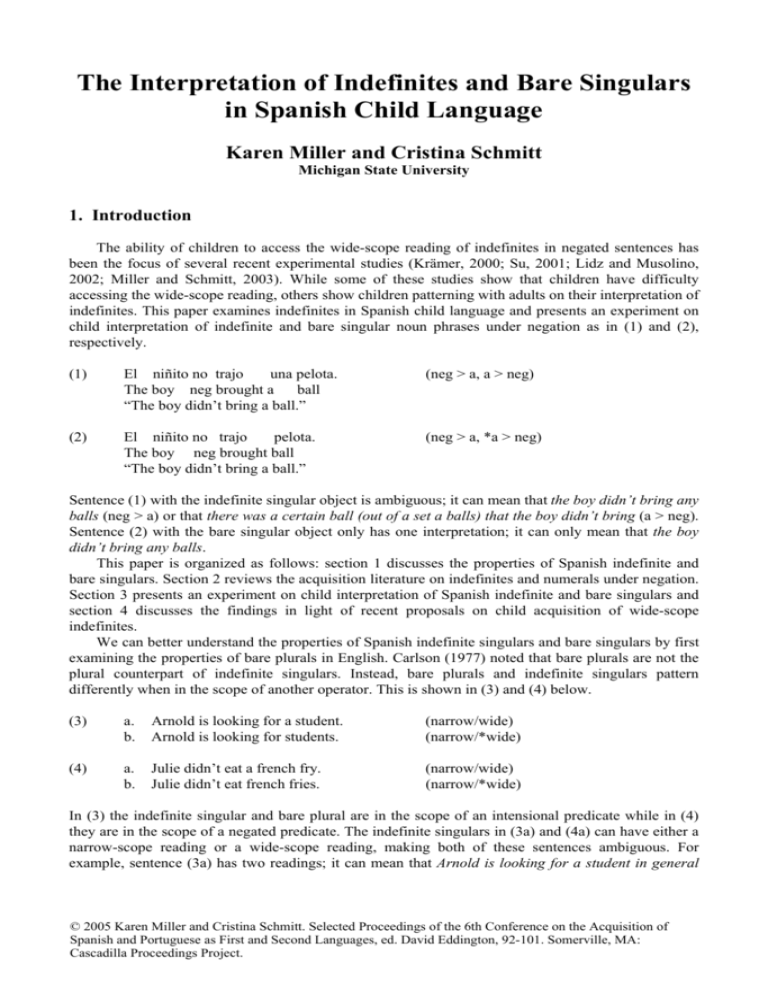
The Interpretation of Indefinites and Bare Singulars
in Spanish Child Language
Karen Miller and Cristina Schmitt
Michigan State University
1. Introduction
The ability of children to access the wide-scope reading of indefinites in negated sentences has
been the focus of several recent experimental studies (Krämer, 2000; Su, 2001; Lidz and Musolino,
2002; Miller and Schmitt, 2003). While some of these studies show that children have difficulty
accessing the wide-scope reading, others show children patterning with adults on their interpretation of
indefinites. This paper examines indefinites in Spanish child language and presents an experiment on
child interpretation of indefinite and bare singular noun phrases under negation as in (1) and (2),
respectively.
(1)
El niñito no trajo
una pelota.
The boy neg brought a
ball
“The boy didn’t bring a ball.”
(neg > a, a > neg)
(2)
El niñito no trajo
pelota.
The boy neg brought ball
“The boy didn’t bring a ball.”
(neg > a, *a > neg)
Sentence (1) with the indefinite singular object is ambiguous; it can mean that the boy didn’t bring any
balls (neg > a) or that there was a certain ball (out of a set a balls) that the boy didn’t bring (a > neg).
Sentence (2) with the bare singular object only has one interpretation; it can only mean that the boy
didn’t bring any balls.
This paper is organized as follows: section 1 discusses the properties of Spanish indefinite and
bare singulars. Section 2 reviews the acquisition literature on indefinites and numerals under negation.
Section 3 presents an experiment on child interpretation of Spanish indefinite and bare singulars and
section 4 discusses the findings in light of recent proposals on child acquisition of wide-scope
indefinites.
We can better understand the properties of Spanish indefinite singulars and bare singulars by first
examining the properties of bare plurals in English. Carlson (1977) noted that bare plurals are not the
plural counterpart of indefinite singulars. Instead, bare plurals and indefinite singulars pattern
differently when in the scope of another operator. This is shown in (3) and (4) below.
(3)
a.
b.
Arnold is looking for a student.
Arnold is looking for students.
(narrow/wide)
(narrow/*wide)
(4)
a.
b.
Julie didn’t eat a french fry.
Julie didn’t eat french fries.
(narrow/wide)
(narrow/*wide)
In (3) the indefinite singular and bare plural are in the scope of an intensional predicate while in (4)
they are in the scope of a negated predicate. The indefinite singulars in (3a) and (4a) can have either a
narrow-scope reading or a wide-scope reading, making both of these sentences ambiguous. For
example, sentence (3a) has two readings; it can mean that Arnold is looking for a student in general
© 2005 Karen Miller and Cristina Schmitt. Selected Proceedings of the 6th Conference on the Acquisition of
Spanish and Portuguese as First and Second Languages, ed. David Eddington, 92-101. Somerville, MA:
Cascadilla Proceedings Project.
93
(narrow-scope reading of the indefinite) or that there is a particular student that Arnold is looking for
(wide-scope reading of the indefinite). The same is true for sentence (4a). On the other hand, the bare
plurals in sentences (3b) and (4b) can only have a narrow-scope reading. These sentences can only
mean that Arnold is looking for students in general and Julie didn’t eat any french fries.
Spanish bare singulars behave a lot like bare plurals except that their distribution is much more
restricted. The examples in (5) and (6) show that Spanish bare singulars and indefinite singulars also
pattern differently when in the scope of intensional and negated predicates, with bare singulars only
allowing a narrow-scope reading, as shown in the (b) sentences.
(5)
(6)
a.
Nicolás está buscando una casa.
Nicolás is looking for a
house
“Nicolás is looking for a house.”
(neg > a, a > neg)
b.
Nicolás está buscando casa.
Nicolás is looking for house
“Nicolás is looking for a house.”
(neg > a, *a > neg)
a.
Pedro no trajo
una pelota.
Pedro neg brought a
ball
“Pedro didn’t bring a ball.”
(neg > a, a > neg)
b.
Pedro no trajo
pelota.
Pedro neg brought ball
“Pedro didn’t bring a ball.”
(neg > a, *a > neg)
Sentences (5a) and (5b) are ambiguous; (5a) can mean that Nicolás is looking for any house (i.e. he is
house-hunting) or this sentence can mean that there is a certain house that Nicolás is looking for (i.e. a
friend’s house). Sentence (6a) can have the interpretation that Pedro didn’t bring any balls or that
there was a particular ball (out of a set of balls) that Pedro didn’t bring.
Unlike bare plurals, the distribution of Spanish bare singulars is restricted (Bosque, 1996).
Spanish bare singulars can occur only in complement position, and are licensed under negation,
intensional predicates in questions and with a certain class of verbs that seem to belong to a semantic
class associated to HAVE or not HAVE. Some examples are shown below in Table 1.
Table 1. Spanish Bare Singulars
a. Ando buscando casa.
I go looking for house
“I am house-hunting.”
b. Me falta cuchara.
Me lacks spoon
“I am missing a spoon.”
secretaria?
c. ¿Hay
Is there secretary
“Is there a secretary?”
d. Tengo casa en Punta Arenas.
I have house in Punta Arenas
“I have a house in Punta Arenas.”
e. Me compré auto.
I bought car
“I bought a car.”
f. Me conseguí perro.
Me I got
dog
“I got myself a dog.”
g. No trajo
pelota.
neg he brought ball
“He didn’t bring a ball.”
h. Quiero usar computador.
I want to use computer
“I want to use a computer.”
i. No tengo camisa limpia.
neg I have shirt clean
“I don’t have a clean shirt.”
j. Rodrigo necesitaba ayudante.
Rodrigo needed
assistant
“Rodrigo needed an assistant.”
k. ¡Encontré polola!
I found girlfriend
“I got myself a girlfriend!”
l. Tomamos colectivo.
Let’s take taxi
“Let’s take a taxi.”
94
The distribution of nonspecific indefinites is not unique to Spanish. For example, Matthewson
(1999) discusses the distribution of what she refers to as polarity indefinites in St’át’imcets (Lillooet
Salish). Although St’át’imcets indefinite determiners are marked for number and spatio-temporal
distance from the speaker, polarity indefinites are headed by the determiner ku which lacks these
features. In other words, like Spanish bare singulars, indefinites headed by ku are featureless.
Matthewson notes that St’át’imcets polarity indefinites are licensed by modals, negation and in
questions and they always have a narrow-scope reading. Farkas and de Swart (2003) discuss what they
refer to as PredOp bare nominals in Hungarian that are also licensed by negation in addition to the
progressive aspect and the subjunctive. Again, these bare nominals always have a narrow-scope
reading. Van Geenhoven (1998) discusses incorporating nouns in West Greenlandic, which always
have a narrow-scope reading. Interestingly, verbs that incorporate nouns in West Greenlandic are very
similar to those that take bare singulars in Spanish. Some examples are get, buy, have, look for, sell,
and eat. Finally, Neidle (1988) points out that indefinite direct objects marked with genitive case (as
apposed to accusative case) in Russian always take narrow-scope. The genitive case on indefinite
objects is licensed by negation and also by verbs like achieve, attain, want, look for and wish for.
Although this list of non-specific indefinites is not exhaustive, it is easy to find patterns in their
distribution. Like Spanish bare singulars, they are often licensed by negation, in questions and under a
certain class of verbs.
One account of Spanish bare plurals and bare singulars, put forth by Masullo (1992), proposes that
they are defective nominal projections (not DPs but NPs) that must incorporate to a verb or preposition
in order to satisfy the Visibility Condition. Since there is no overt manifestation of incorporation, these
nominals must incorporate at LF. Evidence for his analysis includes the absence of Spanish bare
nominals in subject position (as in (7)), where they are unable to incorporate, and the requirement of
strict adjacency between the verb/preposition and the bare nominal that must incorporate to it (as in
(8)).
(7)
(8)
a.
El niñito no trajo
pelota.
The boy neg brought ball
“The boy didn’t bring a ball.”
b.
*Ninito no trajo
pelota.
Child neg brought ball
“A child didn’t bring a ball.”
a.
Llegaron ayer
todos los invitados.
Arrived yesterday all
the guests
“All the guests arrived yesterday.”
b.
*Llegaron ayer
invitados.
Arrived
yesterday guests
“Guests arrived yesterday.”
Although there is no exact consensus on the appropriate analysis of the lexical distribution of Spanish
bare singulars (under negation, in questions and with a certain class of verbs), there are two properties
of Spanish bare singulars that are important for the purposes of the experiment presented in this paper.
First, Spanish bare singulars, are syntactically restricted to object position and secondly, bare
singulars, unlike indefinite singulars, always receive the narrowest scope.
2. Wide-scope Indefinites in Child Language
Several experimental studies have looked at whether children can access both the wide-scope and
the narrow-scope readings of indefinites. The following experimental studies look specifically at
95
whether children can access both readings when these indefinites occur in sentences involving
negation.
Krämer (2000) examined child interpretation of indefinite singulars in Dutch. Dutch object noun
phrases have either a wide-scope or narrow-scope reading depending on the surface position of the
indefinite. If the indefinite occurs lower than negation, it has an obligatory narrow-scope reading in the
adult grammar (as shown in (9a)). If it occurs higher than negation, it has an obligatory wide-scope
reading (as shown in (9b)).
(9)
a.
De jongen heeft geen vis gevangen.
The boy has not+a fish caught
“The boy didn’t catch a fish.”
(neg > a; *a > neg)
b.
De jongen heeft een vis niet gevangen.
The boy has a fish not caught
“The boy didn’t catch a fish.”
(*neg > a; a > neg)
The results of this study showed that Dutch children between the ages of 4 - 7 years old (mean: 5;8) do
not distinguish between these two sentence types; instead, they assign narrow-scope readings to both
scrambled and unscrambled object noun phrases.
In a similar study, Su (2001) examined child interpretation of indefinite noun phrases in English
and Chinese by testing sentences like those shown in (10). Children were between 3 – 5 years old
(mean: 5;0).
(10)
a.
Milaoshu
meiyou qi yi-zhi gou.
Mickey Mouse didn’t ride a-CL dog
“Mickey Mouse didn’t ride a dog.”
(neg > a; a > neg)
b.
Mickey Mouse didn’t ride a dog.
(neg > a; a > neg)
Both Chinese and English indefinite objects in (10) are ambiguous between a wide-scope and narrowscope reading. While English children differed significantly from English adults by preferring a
narrow-scope interpretation of the indefinite, Chinese children patterned with Chinese adults by
preferring what appeared to be a wide-scope interpretation.
Lidz and Musolino (2002) tested 3 – 4 year-old (mean: 4;4) English- and 4 year-old (mean: 4;5)
Kannada-speaking children on their interpretation of ambiguous sentences involving quantified noun
phrases and negation, as in (11).
(11)
a.
Donald didn’t find two guys.
(neg > two; two > neg)
b.
Anoop eradu kaaru toley-al-illa.
Anoop two car
drive-inf-neg
“Anoop didn’t drive two cars.”
(neg > two; two > neg)
They found that while adults readily access either scopal interpretation for the quantified noun phrase,
English- and Kannada-speaking children prefer the narrow-scope reading of the quantified noun
phrase.
Two proposals put forth to account for previous findings on child interpretation of indefinites are
the Non-Integration Hypothesis (Kramer, 2000) and what we will call the Number Reading Hypothesis
based on Su (2001). The Non-Integration Hypothesis proposes that children acquire the predicative
interpretation of indefinites early and the specific interpretation later (after age 7). The specific
interpretation is acquired later because it requires discourse integration and children are unable to
integrate discourse at this age.
96
The Number Reading Hypothesis proposes that the difference between English and Chinese child
interpretation of indefinites (Chinese children patterned with adults while English children did not) is
due to the lexical differences between English a and Chinese yi-ge. In Chinese, yi-ge is also the word
for one while this is not true for the English indefinite. Chinese number expressions can be quantitydenoting or quantificational when lexically governed (Li, 1998). In Su’s study, an answer of “true”
could mean that the child accessed either a quantity-denoting reading (scopeless) or a wide-scope
reading of the indefinite/numeral while an answer of “false” means that the child accessed the narrowscope reading of the indefinite. Su suggests that in the experiment Chinese children behaved
differently from English-speaking children (Chinese children provided more “true” responses) because
Chinese children have a quantity-denoting reading of the indefinite (i.e. Mickey mouse didn’t ride one
dog, he rode three).
3. Main Experiment: Spanish Bare Singulars and Indefinite Singulars
Given the findings of previous experiments, Spanish is an interesting language to test because it
has an indefinite article that is ambiguous in denoting either an indefinite or the number one (un/una)
but also allows bare singulars with obligatory narrow-scope in a restricted set of contexts. If as
predicted by the Non-integration Hypothesis, children are unable to access a specific interpretation for
indefinites under negation, Spanish children should always interpret bare singulars as having a narrowscope reading. Moreover, Spanish children should also prefer the narrow-scope reading for indefinite
singulars. If this is the case, they should treat bare singulars and indefinite singulars identically.
However, if, as predicted by the Number Hypothesis, that the numerical form of the indefinite singular
plays a role in child interpretation of these sentences, then Spanish children, like Chinese children,
should pattern with adults on their interpretation of indefinite singulars. In this case, they should not
treat bare singulars and indefinite singulars identically. The goal of this study is to test whether
Spanish children understand the lack of scope ambiguities in Spanish bare singulars and whether they
treat indefinite singulars and bare singulars the same.
The target sentences in the present study involved Spanish bare singulars and indefinite singulars
under negation. As noted above, while indefinite singulars under negation are ambiguous between a
narrow-scope and a wide-scope interpretation (as shown in (12)), bare singulars under negation have
only a narrow-scope interpretation (as shown in (13)).
(12)
El niño no se compró un perro.
The boy neg rfl bought a dog
“The boy didn’t buy a dog.”
(neg > a; a > neg)
(13)
El niño no se compró perro.
The boy neg rfl bought dog
“The boy didn’t buy a dog.”
(neg > a; *a > neg)
Sentence (12) with the indefinite singular can mean that the boy didn’t buy any dogs or that there was
a particular dog (out of a set of dogs) that the boy didn’t buy while sentence (13) with the bare singular
can only mean that the boy didn’t buy any dogs.
3.1 Participants
We tested 24 Spanish-speaking children between the ages of 4;5 and 5;11 (mean: 5;0). All
children were recruited from daycare centers and kindergartens in the city of Punta Arenas, Chile. In
addition, we tested 30 Spanish-speaking adults, all of whom were undergraduates at the Universidad
de Magallanes located in Punta Arenas, Chile.
97
3.2 Procedure
We tested child interpretation of sentences like (12) and (13) by using the Truth Value Judgment
task (Crain & Thornton, 1998). Participants listened as an experimenter read a short story presented on
picture cards. At the end of the story, a puppet made a statement about what he believed happened in
the story. Participants had to determine whether the puppet’s statement accurately described the story
or not.
All children were tested individually in a quiet classroom. Before running the task there was a
practice session in which the puppet had to guess the age and name of the child. This allowed each
child to become comfortable with the task. Afterwards, each child was presented with two fillers (one
in which the puppet’s statement was true and one in which the puppet’s statement was false). If the
child answered both filler items correctly, they would be presented with 18 more stories. There were
four experimental stories which involved sentences with indefinite singulars like those in (12), four
experimental stories which involved sentences with bare singulars like those in (13), four controls, and
eight fillers. Stories were presented in pseudo-random order.
Adult participants were tested in quiet classrooms in groups of three to five. Stories were
presented on picture cards in the same way they were presented to children. However, instead of
feeding the puppet, participants were given a score sheet and were instructed to indicate whether the
puppet’s statement was an accurate or inaccurate description of the story.
3.3 Materials
The experimental stories were the same in both the Bare Singular and Indefinite Singular
conditions. The stories were written so that either an answer of “true” or “false” was correct in the
Indefinite Singular condition. An answer of “true” indicated a wide-scope interpretation of the
indefinite while an answer of “false” indicated a narrow-scope interpretation of the indefinite. In the
Bare Singular condition, “false” (a narrow-scope interpretation) was the only correct answer. All
experimental stories were presented on a set of three cards. Figure 1 shows a sample experimental
story.
Figure 1. Sample Experimental Story
Card 1
Card 2
Este niño está pensando en
llevar algo al jardín para
jugar con sus amigos.
Primero, pensó en llevar sus
pelotas pero después decidió
llevar sus peluches.
Así es que el niño fue a
buscar sus peluches pero se
acordó que a sus amigos les
gusta jugar a la pelota. Así es
que decidió no llevar ningún
peluche.
(plausible dissent)
Card 3
Al final el niño decidió traer
sus pelotas al jardín. El niño
trajo la pelota amarilla, la
pelota azul y la pelota verde,
pero no trajo la pelota
naranja
porque
estaba
desinflada.
The experimental story translated in English is as follows: Card 1: This boy is thinking about taking
something to school to share with his friends. First he thought about taking his balls but he thought
he’d rather take his teddy bears instead. Card 2: So he went to find his teddy bears and then he
remembered that his friends really liked playing soccer. So he decided not to bring any teddy bears.
98
Card 3: So finally the boy decided to bring his balls to school. He brought the yellow ball, the blue
ball and the green ball but he didn’t bring the orange ball because it was flat (had no air in it).
After hearing the target story, participants were presented either with an Indefinite Singular
sentence (as in (14)) or a Bare Singular sentence (as in (15)) and had to decide whether the sentence
was an accurate description of the story or not.
(14)
El niño no trajo
una pelota.
The boy neg brought a
ball
“The boy didn’t bring a ball.”
(neg > a; a > neg)
(15)
El niño no trajo
pelota.
The boy neg brought ball
“The boy didn’t bring a ball.”
(neg > a; *a > neg)
All of the target sentences are shown in Table 2. To ensure that a particular noun was not
responsible for participant responses, we divided sentences up into two groups. Half of the participants
received the sentences in Set A in the Bare Singular condition and the sentences in Set B in the
Indefinite Singular condition while the other half received the sentences in Set A in the Indefinite
Singular condition and those in Set B in the Bare Singular condition. All children and adults received
four experimental sentences from both the Bare Singular and Indefinite Singular conditions giving rise
to a 2 X 2 mixed design with Condition as a within subjects factor and Age as a between subjects
factor.
Table 2. Experimental Sentences in both Conditions
Set B: Indefinite Singular
Set A: Bare Singular
1. La niñita no se compró polera.
The girl neg rfl bought shirt
“The girl didn’t buy a shirt.”
1. El chico no se compró un perro.
The boy neg rfl bought a dog
“The boy didn’t buy a dog.”
2. El niño no usó lápiz.
The boy neg used pencil
“The boy didn’t use a pencil.”
2. La niña no usó un computador.
The girl neg used a computer
“The girl didn’t use a computer.”
3. El chico no trajo
pelota.
The boy neg brought ball
“The boy didn’t bring a ball.”
3. El chico no trajo una bicicleta.
The boy neg brought a bicycle
“The boy didn’t bring a bicycle.”
4. La señora no se puso chaqueta.
The lady neg rfl put on jacket
“The lady didn’t put on a jacket.”
4. La señora no se puso un vestido.
The lady neg rfl put on a dress
“The lady didn’t put on a dress.”
3.4 Results
Graph 1 shows the percentage of narrow-scope responses for adults and children.
99
Graph 1. Percentage of narrow-scope responses per condition
100%
80%
99%
76%
60%
36%
40%
43%
bare
indefinite
20%
0%
children
adults
Note: A narrow-scope response (answer “false”) for the bare
singular condition is the only correct response, while the
indefinite condition is ambiguous so either “false” or “true” are
available in the adult grammar.
The dependent measure is the number of times participants rejected (indicating a narrow-scope
interpretation) target sentences. Adults rejected target sentences 43% of the time while children
rejected target sentences 36% of the time in the indefinite singular condition. On the other hand, adults
rejected target sentences in the Bare Singular condition 99% of the time and children 76% of the time.
The proportion of “false” responses for each participant was entered into a 2 (Age: adults, 4-5 year old
children) X 2 (Condition: bare singular, indefinite singular) mixed design Analysis of Variance
(ANOVA) with Condition as a within subjects variable and Age as a between subjects variable. The
analysis revealed a main effect for Age (F(1,52) = 4.388, p = .041) and a main effect for Condition
(F(1,52) = 61.781, p = .0005). However, there was no significant interaction between Age and
Condition (F(1,52) = 1.641, p = .206. The main effect for Condition indicates that like adults, children
between the ages of 4 and 5 distinguish between bare singulars and indefinite singulars. The main
effect for Age indicates that children are still not reaching adult levels on their interpretation of bare
singulars and indefinite singulars. However, despite this fact, these findings do not challenge the
underlying observation that Spanish children, like Spanish adults, are clearly treating bare singulars
differently from indefinite singulars.
4. Discussion and Conclusion
The experiment presented in this paper examined child interpretation of Spanish bare singulars
and indefinite singulars under negation. Specifically, we asked whether Spanish-speaking children
would distinguish between both types of indefinites or whether they would treat them identically. The
results presented above clearly show that like Spanish-speaking adults, Spanish-speaking children by 4
years of age distinguish between bare singulars and indefinite singulars. This means that Spanishspeaking children know that bare singulars have obligatory narrow-scope while indefinite singulars are
ambiguous.
One proposal put forth to account for child interpretation of indefinites is the Non-integration
Hypothesis (Krämer, 2000). This hypothesis proposes that children start out with the predicative, nonspecific interpretation of indefinites and it is only later (after age 7) that children acquire the free
variable, specific reading of indefinites (see Krämer, 2000 for more details). Our findings do not
appear to support the Non-integration Hypothesis as Spanish-speaking children are able to distinguish
between the obligatory non-specific (narrow-scope) reading and the optional specific (wide-scope)
reading of indefinite singulars and for children to interpret indefinite singulars specifically, they must
use information from prior discourse; in other words, they must be able to integrate discourse when
assigning an interpretation to the indefinite (i.e. the child must remember that one of the balls was left
unaffected in the sample story in Figure 1 in order to get the reading there was a ball that the boy
100
didn’t take). However, before we can conclude that the results of the present study do not support the
Non-integration Hypothesis, we must first take a look at our results in light of the Number Reading
Hypothesis.
Su (2001) suggested that Chinese children behave differently from English-speaking children
because of the lexical nature of the indefinites in both languages; in Chinese the indefinite is identical
in form to the word for one but this is not true for English. Su (2001) concluded that Chinese children
have a number, scope-independent reading of the indefinite while English-speaking children have a
narrow-scope reading of the indefinite. It is possible that, as in the Chinese case, the lexical nature of
the Spanish indefinite article may be playing a role in the interpretation of these sentences.
Table 3 shows the percentage of narrow-scope readings for indefinite singulars in the experiments
discussed in section 2. Experiments were run in four different languages, and in all four, experimental
sentences involved negation. Note that in adult Dutch scrambled indefinites have obligatory widescope readings, while in adult English, Chinese and Spanish indefinites under negation are ambiguous;
they can have a narrow or wide-scope reading. This explains why Dutch adults behave so differently
from English, Chinese and Spanish adults.
Table 3. Percentage of Narrow-scope Readings of Indefinites Under Negation
Dutch
English
Chinese
Spanish
Krämer
Su
Su
(2000)
(2001)
(2001)
Children
84%*
67%*
23%
36%
Adults
0%
50%
36%
43%
* significant (p<.05) difference between child and adult responses.
Table 3 shows that while Dutch and English children rejected target sentences significantly more often
than adults, Chinese and Spanish-speaking children pattern with adults. The results from Dutch
indicate that children are unable to access the wide-scope interpretation for indefinite singulars since
this is the only interpretation allowed in adult Dutch in the scrambled condition. The results from
English-speaking children indicate a preference for a narrow-scope interpretation of indefinites.
Although Chinese and Spanish experimental sentences were ambiguous, just like the English
experimental sentences, there is a reduction in the amount of narrow-scope interpretations by adults
and more interestingly Chinese and Spanish children patterned with adults (there was not a significant
difference between child and adult responses). This finding makes sense if we take a closer look at the
interpretations available for the Spanish and Chinese indefinite singulars.
There is at least one additional interpretation for Chinese and Spanish sentences that is not
available for English or Dutch sentences because of the lexical nature of the indefinites in these four
languages.
(16)
Milaoshu
meiyou qi yi-zhi gou.
Mickey Mouse didn’t ride a-CL dog
“Mickey Mouse didn’t ride a/one dog.”
(17)
El niño no trajo
una pelota.
The boy neg brought a
ball
“The boy didn’t bring a/one ball.”
Sentences (16) and (17) have at least three possible interpretations. Sentence (17), for example, can
mean that (i) the boy didn’t bring any balls (neg > a), (ii) the number of balls that the boy didn’t bring
is one (number reading), and (iii) there was a particular ball (out of a set of balls) that the boy didn’t
bring (a > neg). If participants rejected sentence (17) after hearing the story in Figure 1, they would be
accessing interpretation (i); however, if participants accepted this sentence as an accurate description
of the story, they could be accessing one of two possible interpretations, either (ii) or (iii). Based on
the fact that previous studies have shown that children have difficulty accessing the wide-scope
101
interpretation of the indefinite in negated sentences (but see Miller and Schmitt, 2003), and because
the Spanish indefinite article is lexically ambiguous between having a number reading or an indefinite
reading, we conclude that Spanish-speaking children, like English-, Dutch, and Kannada-speaking
children, are accessing a narrow-scope reading of the indefinite under negation and in addition, like the
Chinese children, are accessing a number reading of indefinites under negation. This being the case,
our findings do not provide evidence against the Non-Integration Hypothesis but they do provide
support for the Number Reading Hypothesis.
The present study set out to test whether Spanish-speaking children distinguish between bare
singulars and indefinite singulars under negation. This study accomplishes this goal by showing that
by four years of age children understand the obligatory narrow-scope property of bare singular objects
and the ambiguity of indefinite singular objects in relation to negation. As a result, Spanish-speaking
children treat bare singulars and indefinite singulars differently. Based on our findings as well as
findings from several experimental studies on child interpretation of indefinites, we suggest that
Spanish-speaking children are accessing a narrow-scope reading and number reading of the indefinite.
Notes
*
Acknowledgements: This experiment was funded in part by the Tinker Field Research Grant, Latin American
and Caribbean Studies Program at Michigan State University. We would like to especially thank the teachers,
parents and children affiliated with the Jardín Bambi and the British School in Punta Arenas, Chile. We would
also like to thank La junta nacional de jardines infantiles de Chile (JUNJI) and students and faculty at the
Universidad de Magallanes, Chile for their cooperation and support. Special thanks to Rodrigo Cárdenas who
spent several hours recruiting and testing children and adults and for his helpful comments. We would like to
thank Ana Teresa Pérez-Leroux, Alan Munn and the language acquisition group at Michigan State University for
discussion and insightful suggestions about the experiment and results.
References
Bosque, Ignacio. 1996. Por qué determinados sustantivos no son sustantivos determinados. In: El sustantivo sin
determinación: la ausencia de determanante en la lengua española, ed. by Ignacio Bosque, 13-120. Madrid:
Visor Libros.
Carlson, Greg. 1977. Reference to Kinds in English. University of Massachusetts dissertation. [Published 1980
Garland Press, New York.].
Crain, Stephen and Rosalind Thornton. 1998. The Truth Value Judgment Task: Fundamentals of Design.
University of Maryland Working Papers in Linguistics 6:61-70.
Farkas, Donka and Henriette de Swart. 2003. The semantics of incorporation. CSLI Publications.
Krämer, Irene. 2000. Interpreting Indefinites: An experimental study of children’s language comprehension.
University of Utrecht dissertation.
Li, Y.-H. Audrey. 1998. Argument determiner and number phrases." Linguistic Inquiry 29(4):693-702.
Lidz, Jeffrey and Julian Musolino. 2002. Children’s command of quantification. Cognition 84:113-154.
Masullo, Pascual. 1992. Incorporation and Case theory in Spanish: a crosslinguistic perspective. University of
Washington dissertation.
Matthewson, Lisa. 1999. On the Interpretation of Wide-scope Indefinites. Natural Language Semantics 7:79
134.
Miller, Karen and Cristina Schmitt. 2003. Wide-scope Indefinites in English Child Language. Paper presented at
the Generative Approaches to Language Acquisition Conference (GALA), Utrecht, Sept. 6.
Musolino, Julian. 1998. Universal Grammar and the Acquisition of Semantic Knowledge: An Experimental
Investigation into the Acquisition of Quantifier Negation Interaction in English. University of Maryland
dissertation.
Neidle, Carol. 1988. The Role of Case in Russian Syntax. Kluwer Academic Publishers.
Su, Yi-ching. 2001. Scope and Specificity in Child Language. BUCLD 25 Proceedings, 744-755. Somerville, MA:
Cascadilla Press.
Van Geenhoven, Veerle. 1998. Semantic Incorporation and Indefinite Descriptions: Semantic and Syntactic
Aspects of Noun Incorporation in West Greenlandic. Stanford, CA: CSLI Publications.
Selected Proceedings of the 6th Conference
on the Acquisition of Spanish and
Portuguese as First and Second Languages
edited by David Eddington
Cascadilla Proceedings Project
Somerville, MA
2005
Copyright information
Selected Proceedings of the 6th Conference on the Acquisition
of Spanish and Portuguese as First and Second Languages
© 2005 Cascadilla Proceedings Project, Somerville, MA. All rights reserved
ISBN 1-57473-404-0 library binding
A copyright notice for each paper is located at the bottom of the first page of the paper.
Reprints for course packs can be authorized by Cascadilla Proceedings Project.
Ordering information
Orders for the library binding edition are handled by Cascadilla Press.
To place an order, go to www.lingref.com or contact:
Cascadilla Press, P.O. Box 440355, Somerville, MA 02144, USA
phone: 1-617-776-2370, fax: 1-617-776-2271, e-mail: sales@cascadilla.com
Web access and citation information
This entire proceedings can also be viewed on the web at www.lingref.com. Each paper has a unique document #
which can be added to citations to facilitate access. The document # should not replace the full citation.
This paper can be cited as:
Miller, Karen and Cristina Schmitt. 2005. The Interpretation of Indefinites and Bare Singulars in Spanish Child
Language. In Selected Proceedings of the 6th Conference on the Acquisition of Spanish and Portuguese as First
and Second Languages, ed. David Eddington, 92-101. Somerville, MA: Cascadilla Proceedings Project.
or:
Miller, Karen and Cristina Schmitt. 2005. The Interpretation of Indefinites and Bare Singulars in Spanish Child
Language. In Selected Proceedings of the 6th Conference on the Acquisition of Spanish and Portuguese as First
and Second Languages, ed. David Eddington, 92-101. Somerville, MA: Cascadilla Proceedings Project.
www.lingref.com, document #1128.

